Review Latest Nails Solo Show Two Dimensional Art Building Sculptures New York
Contemporary Mobile Sculptures – Expanding Calder'due south Art Form – Part ii
This is a continuation in progress (every bit of December 2021) of my previous mail service Gimmicky Mobile Sculptures – Expanding Calder'due south Fine art Course with new mobile sculptures that I'm currently working on:


These are images of 3d models of the mobile sculptures that I'm working on expanding, with the balance betoken for each part precisely calculated. Each of these mobile sculptures has an interconnected remainder structure throughout, just like an Alexander Calder mobile. The remainder of each part is bridle by the weight of the parts connected to it. This specific mobile sculpture, for example, is made of 51 balanced parts that are continued to each other, resulting in merely one suspension point for the whole sculpture:

One of these mobile sculptures hither shown with the precisely calculated rest points (103 points in total):



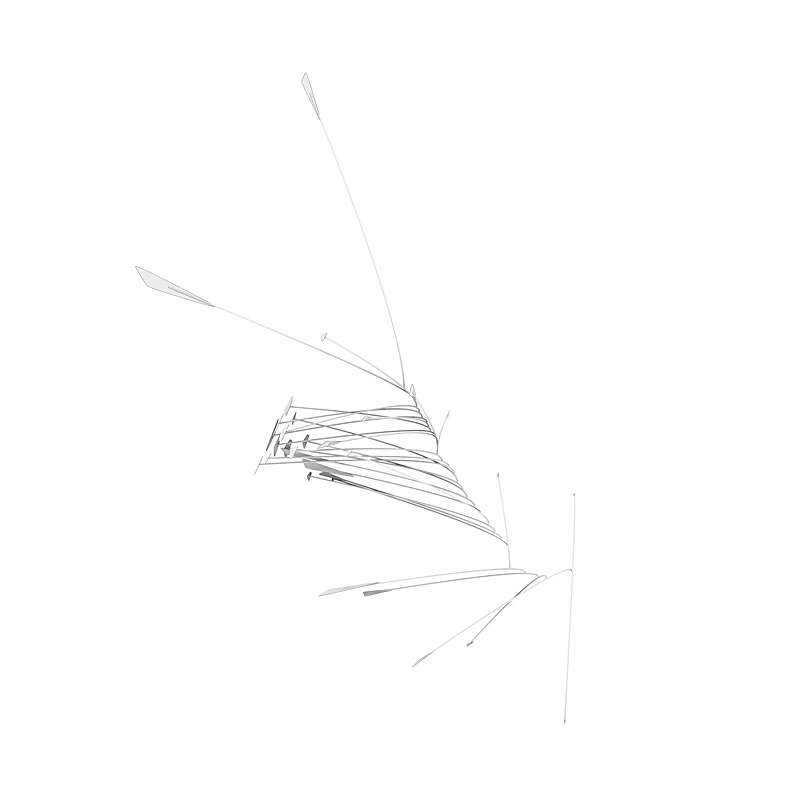



– Meet more of my mobile sculptures –
Contemporary Mobile Sculptures – Expanding Calder'south Fine art Form
What I'thou currently (as of Jan 2022) working on in my patently perpetual endeavour to expand the fine art form of mobiles beyond the limitations of Alexander Calder's piece of work: Calder described his arroyo to designing and making his mobiles in a conversation with Selden Rodman in 1957: "I used to begin with fairly complete drawings, but now I start by cutting out a lot of shapes. Next, I file them and smooth them off. Some I keep because they're pleasing or dynamic. Some are $.25 I just happen to find. So I arrange them, like papier collé, on a table, and "pigment" them – that is, adjust them, with wires between the pieces if it's to be a mobile, for the overall design." His mobiles become iii-dimensional when suspended as each part moves and rotates with the air currents. Just his approach to the layout of a mobile is substantially 2-dimensional, on a table. Calder's Vertical Foliage is good case to illustrate this. However, there seems to be creative approaches to fully three-dimensionally designed mobiles that Calder only very rarely ventured into (his mobile Crimson Cascade made in 1960 is an instance). Here are some of the ideas and experiments that I'thousand currently working on and experimenting with, finding ways to expand his approach (and at that place'south besides a continuation of this mail Contemporary Mobile Sculptures – Expanding Calder'southward Fine art Form – Function 2):
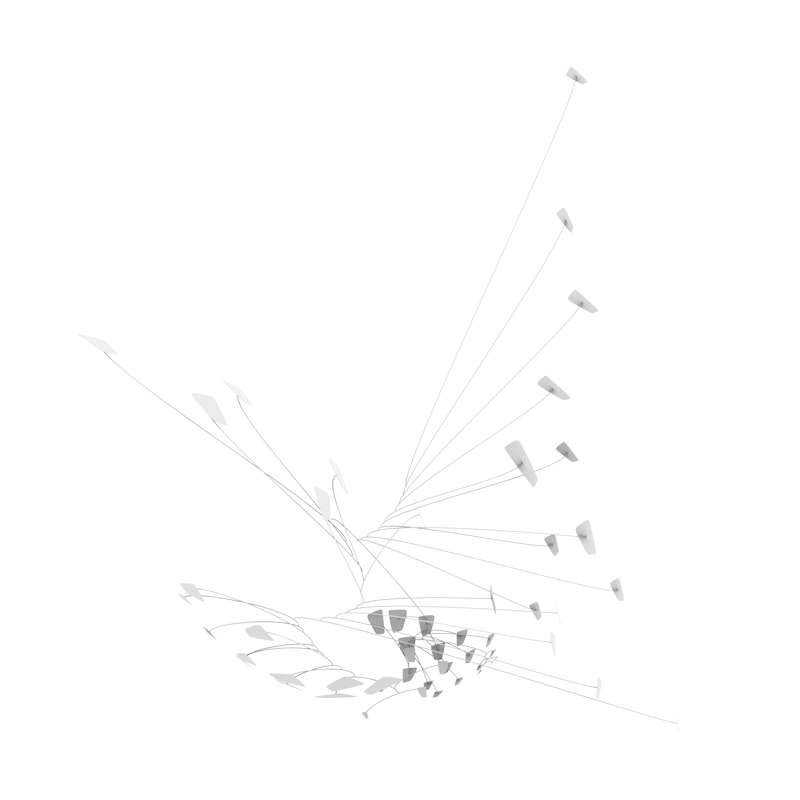



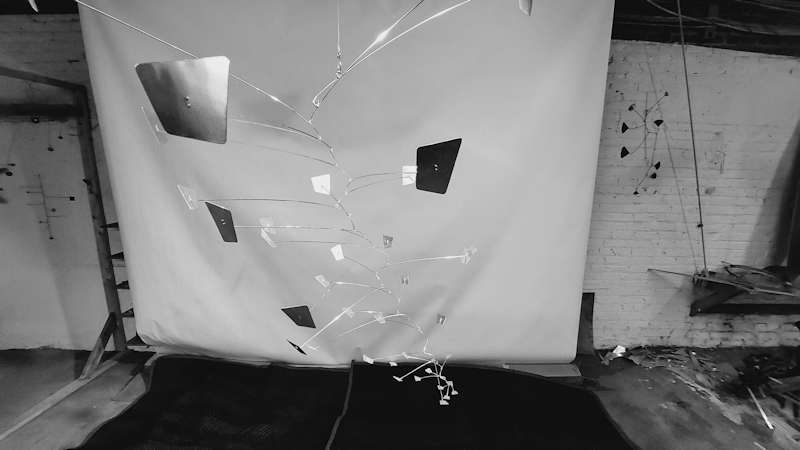
George Rickey, while outlining the early explorations by artists into kinetic fine art from 1912 to 1932 in his book Constructivism – Origins and Evolution (published in 1967, and to my cognition, the about wide-ranging and comprehensive book on the discipline of Constructivism to date), remarked: "It was Calder who succeeded in securing a identify for kinetic fine art. He started making mobiles twelve years afterwards Gabo's Manifesto, and his first exhibition of these was in 1932 at the Galérie Maeght in Paris. Although his mobiles have since become famous and popular and accept enlarged the limits of fine art, his style, deriving from painterly concepts, has had little influence on the new generation, specially the more mechanically inclined. Until his stabiles of the terminal decade, Calder retained a two-dimensional outlook in sculpture devised as outline drawings, often witty, with ingratiating motility added. He seemed indifferent to the wide possibilities of a kinetic art. He discovered a new earth but did not explore information technology."

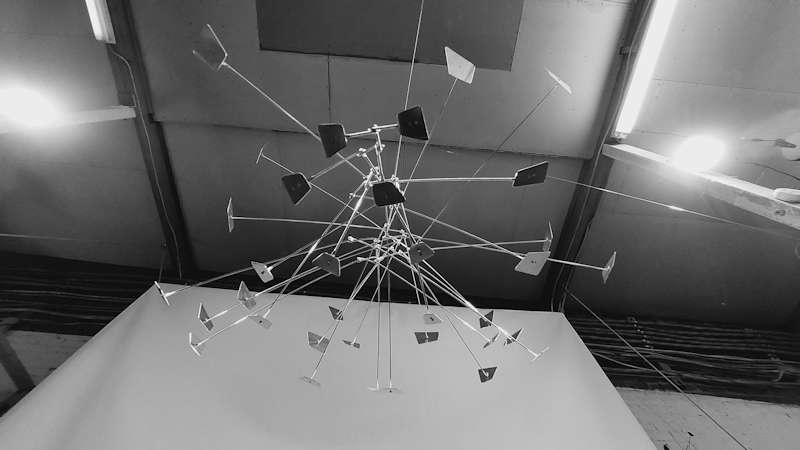

To put the idea in dissimilar words: Calder'south procedure began with seeing Piet Mondrian's paintings and feeling the impulse to brand the static abstract shapes in the paintings motion. He translated this idea to his mobiles quite precisely, substantially creating two-dimensional abstract paintings made of a series of flat shapes that move. Most of them only happen to become three-dimensional considering these two-dimensional abstract "paintings" (essentially two-dimensional planes made of a serial of flat shapes) happen to curve iii-dimensionally when moved by air currents. He remained devoted to this approach with his mobiles and veered from it just very rarely, and not far when he did.
In 1962, in a review in Arts Magazine of an exhibit of Calder's piece of work at Tate [PDF], George Rickey wrote: "The mobile, even if flexible, is ii-dimensional, like a drawing on a condom sheet. The sinuous tracery of each prepare of wires profiles may sit down contrapuntally against the side by side, but flat against flat. With the parts swinging effectually a vertical axis, the galaxy occupies space but does not energize it. Calder has run through the permutations of these wire profiles; still, apart from some perfecting of wire technology, extension and refinement of his vocabulary of shapes (the Arpesque flame forms are the all-time), and increased size, he shows very little accelerate in the expressive use of motion in the xxx years since Calderberry Bush [also known equally Object with Reddish Discs, made in 1932 and regarded as Calder's first mobile sculpture]. It is not the first time that an creative person has been confined past his own invention; information technology happened to Samuel F. B. Morse. The Primary of the Catenaries has become the prisoner of the chain he forged."
To expand Calder's idea, one could create mobiles with the same residual construction every bit Calder's mobiles (based on the whippletree mechanism), and create moving abstruse "paintings" that are truly three-dimensional, non but ii-dimensional planes made of a serial of flat shapes that curve with the air currents.

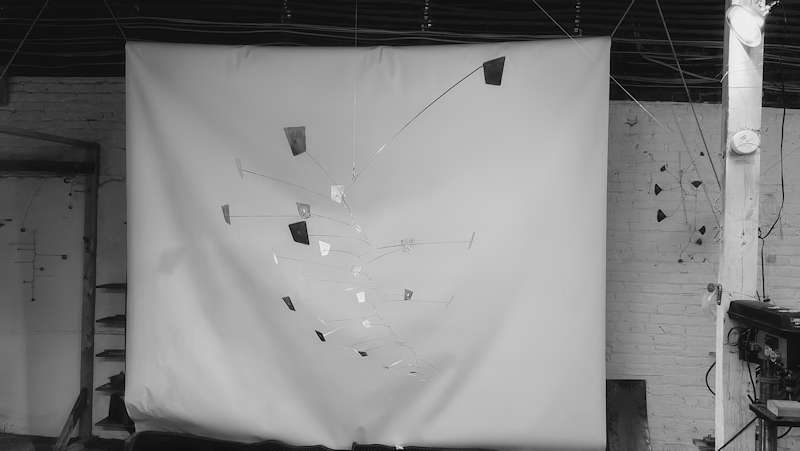


In his later years, Calder designed and made some of his mobiles consisting of 2 (or more than) horizontal and vertical planes, each one existence substantially bundled in 2 dimensions. His hanging mobile titled Lone Red Amid Blacks (1961) is a skilful example to illustrate this. Here again, the 3-dimensionality was a effect of combining two or more "flat" two-dimensional arrangements, not of a fully 3-dimensional organisation.

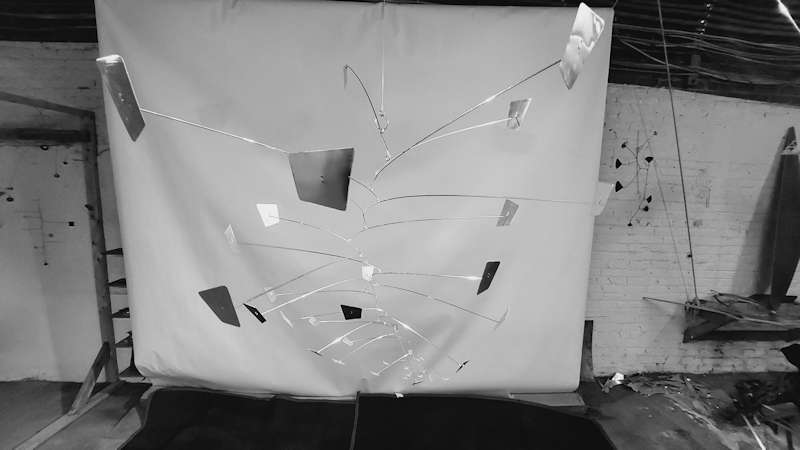
These mobiles shown hither are nonetheless designed with the interconnected remainder construction where the residue of each part depends on the other parts, equally in a Calder mobile. And aforementioned equally in Calder'south mobiles, it's essentially an upside downwardly whippletree mechanism, which probably dates dorsum to between 190 to 209 AD, and has been used to distribute strength evenly through linkages when horses or mules pull a plow or a railroad vehicle:
Human Ray was the first artist (to my noesis) to utilize this balance construction in a suspended sculpture with his piece titled Obstruction in 1920 (if you lot'd similar to read more about the history of mobiles, delight see my page Mobiles earlier Calder – Who Invented Mobiles – A History of Mobiles Part 1).




Nearly all artists who have made mobiles since Calder have adapted his two-dimensional arroyo. Few have worked to move beyond and explore the possibilities of fully three-dimensionally designed mobiles that apply the interconnected residuum structure that distinguishes them from only suspended sculptures (delight see my page Mobile Sculpture Artists – A History of Mobiles – Office 2 for some examples). George Rickey recognized the limitations of Calder's two-dimensional approach to mobiles and expanded the art form, although many of his pieces don't utilize an interconnected balance construction throughout. After around 1950, he often also opted for continuing sculptures instead of suspended ones. Lynn Chadwick, Tim Prentice, Jerome Kirk, Derick Pobell, Laurent Martin "Lo", Philippe Jestin and Jade Oakley take found ways to some extend to costless the art course of mobiles from Calder's two-dimensional approach. Tim Prentice expressed the challenge in a chat with Nicholas Fox Weber (published past Maxwell Davidson Gallery in 2000): "Calder was credited with inventing sculpture with moving parts, so for me Rickey was incredibly of import considering he demonstrated that this concept wasn't any ane man's property. I can practice information technology to a limited degree. I tin draw a line and accept information technology curve, undulate, coil, turn, twist – in that sense, the line is irresolute – and I can do it with planes. The next challenge would be to do it with volume." Volume every bit in three-dimensional planes instead of two-dimensional planes? Or no planes at all?


On the topic of Calder and Rickey, Tim Prentice wrote in his volume Cartoon on the Air – The Kinetic Sculptures of Tim Prentice: "If you compare the two, Calder was a great storyteller [and an entertainer] and not a theorist. When anyone asked him tough questions almost his piece of work, he hid behind his humor. For example, when asked how he knew a piece was finished, he famously answered, "When information technology's dinner time." He operated entirely on intuition. By dissimilarity, Rickey was an intellectual and teacher. He was far more than strict in his use of Constructivist principles. He analytically isolated motion in the style Josef Albers isolated color. [Rickey] and Calder represent the two contrasting sides of the brain." Tim Prentice'due south work greatly expands the art form of mobiles. He seems to build on Rickey'southward approach more than on Calder'southward. Equally he himself has explained: "Equally I concentrated on reducing weight and friction, the decisions came to be based more than on engineering and less on aesthetics" and "nosotros make the machine and keep our creative instincts out of it and the air comes along and does the fine art." Can the contrasting approaches be combined in new ways?


Building on Calder's hanging mobile 13 Spines (1940):



Photos reverse the idea of turning an abstract painting or drawing into a 3-dimensional moving sculpture. They plough information technology back into a flat immobile image made of abstract shapes. Ii-dimensional layouts in mobiles, similar many of Calder's mobiles and the more than conventional mobile sculptures I fabricated some years ago, are easier to capture and comprehend in photos. While video can provide a solution to this, most people discover new art in the form of photos nowadays, especially now in the digital age. You can make an amazing iii-dimensional sculpture, merely if the sculpture doesn't allow you to stand for its idea comprehensively in images and photos, then you're limiting the reach of the thought greatly. As Sarah Sze put it in an interview with Melissa Chiu: "In many means, great artworks are known primarily through photos – so arguably the photos are every bit important as the artworks themselves."

An approach that seems architectural to me:

"Paintings are but inquiry and experiment. I never exercise a painting as a work of art. All of them are researches." – Pablo Picasso, in an interview with Alexander Liberman for Vogue in 1956.
See the continuation of this postal service Contemporary Mobile Sculptures – Expanding Calder'due south Fine art Form – Part ii with additional new mobile sculptures that I'chiliad working on based on this arroyo.
As with anything on my website, if you accept whatever suggestions, anything that should be added, corrected, or accept any questions or comments, delight let me know.
– See more of my mobiles –
Original iii Part Mobile Sculpture
Photos of a custom made mobile, withal to be painted, and based on an boosted design idea from a mobile sculpture fabricated for the picture show The Upside, which in plow was based on my Mobile 92.

Made out of aluminum and stainless steel and with a diameter of lx inches / 150 cm, it weighs less than a pound / less than half a kilogram, and therefor moves with the slightest air currents.
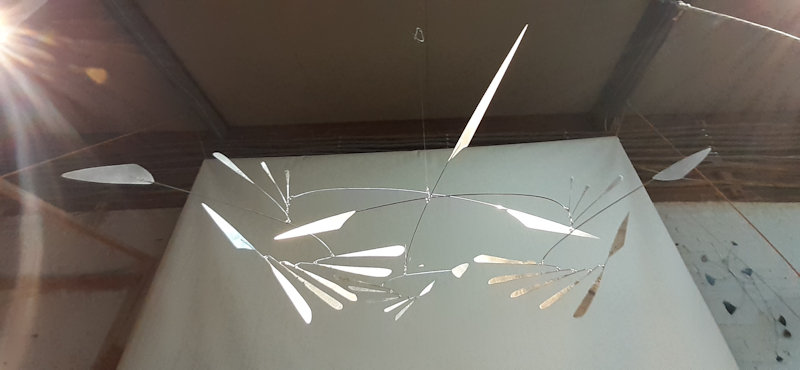
Unlike a conventional mobile by Alexander Calder, this is essentially one mobile made of three mobiles. I believe this is quite unique and original, I've not seen a mobile like it.
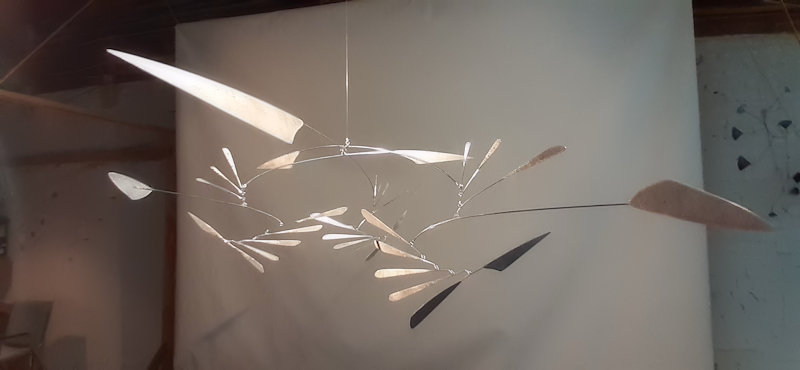
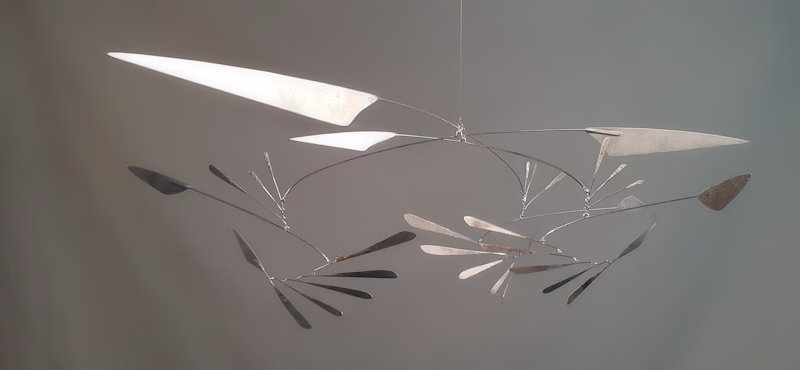


A "fly around" animation of the design:



Painted:

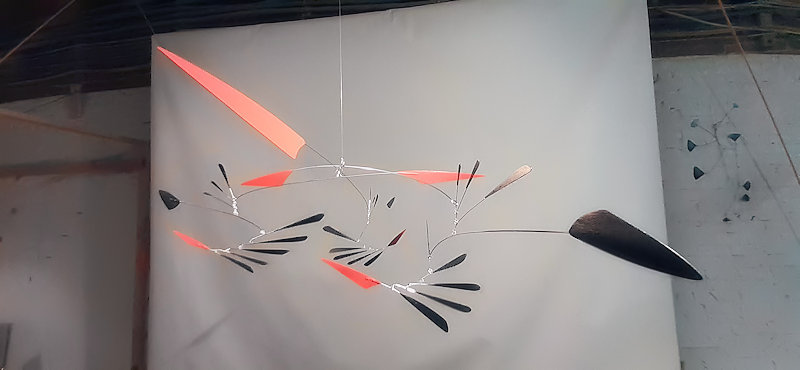
Custom made wooden box for shipping:

– See more of my custom made kinetic sculptures and suspended mobiles –
Marco Mahler gives new life to the kinetic art class Calder made famous – RHome Magazine
New Commodity in R•Dwelling:
Marco Mahler gives new life to the kinetic art form Calder made famous
It talks about how I got inspired by Alexander Calder's mobiles at the National Gallery of Art's Tower 2 in Washington, D.C. to make my first mobiles, and so fabricated small-scale mobiles and kinetic sculptures that I sold on online, got commissioned for a series of mobiles for a New York Style Calendar week, winning 3rd prize in the 2015 International Kinetic Fine art Organization competition, a custom mobile for Robert A. M. Stern, New York architect and dean of architecture at Yale, collaborated with mathematician Henry Segerman to create 3D printed mobiles, a custom designed mobile sculpture that I fabricated for the 2019 movie The Upside starring Bryan Cranston and Nicole Kidman, and some of my new ideas for suspended kinetic sculptures for hereafter projects.

Mobiles shown in the article are Mobile 92 and one of my original contemporary mobile sculptures. Some of the 3d printed mobiles and a shape for a large custom mobile are visible in the background, as well as some of my other contemporary mobiles.
Thanks to Elizabeth Cogar and R•Domicile managing editor Susan Morgan!
Incidentally, a mobile that I custom-made for architect and former Dean of the Yale Schoolhouse of Architecture Robert A.M. Stern for his room at The Kips Bay Designer Bear witness Business firm is featured in the following consequence of R•Habitation Magazine in the feature article about interior designer Doug Stiles and his condo in Richmond's Bellevue Square where the mobile is currently suspended:

Outdoor Standing Mobile Sculpture for Bahamian Residence
Images of an outdoor standing kinetic mobile sculpture I custom designed and custom made for a private residence in the Bahamas this by winter.
The design:

The residence:

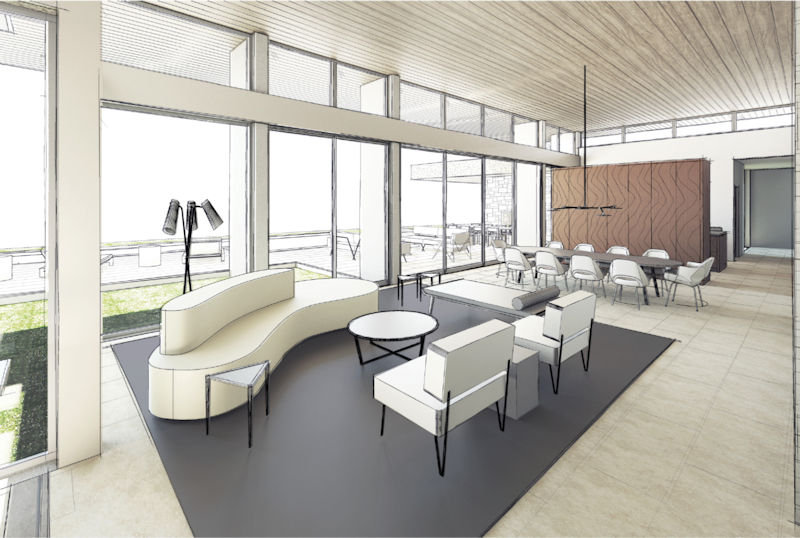
The finished sculpture:

Indoor storage solution for stormy days:

Set for shipping:

Installed on site:

A painting by David Hockney complementing in dynamics and colors hangs on the wall in the groundwork:

– See more of my custom fabricated moving sculptures –
Custom Kinetic Mobile Sculpture for the movie The Upside
In 2017, I made a custom designed mobile for the picture show The Upside, featuring Bryan Cranston, Nicole Kidman and Kevin Hart. The trailer for the picture show in which the mobile is featured several times was released on Oct 3rd 2018, and the flick itself was released on Jan 11, 2019. Information technology reached a full worldwide gross of $122.7 meg. The film follows a paralyzed billionaire (Bryan Cranston) who strikes up an unlikely friendship with a recently paroled convict (Kevin Hart) whom he hires to take care of him. Although not conspicuously implied in the flick merely discussed during the blueprint process, the mobile was a present from Bryan Cranston's grapheme'due south wife who passed away from cancer, and in the movie symbolizes their by love and marriage, every bit well every bit his character'south past passion for paragliding.
In the flick, the mobile is suspended in Bryan Cranston's character's bedroom:

Nicole Kidman with the mobile in the moving-picture show:

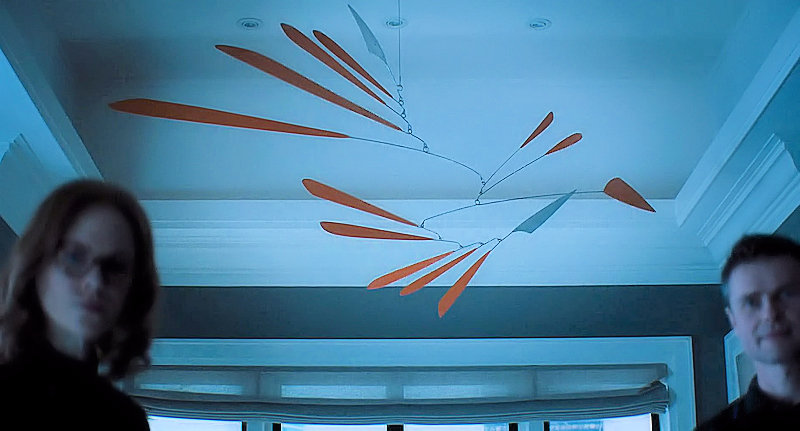
Kevin Hart with the mobile in the pic:


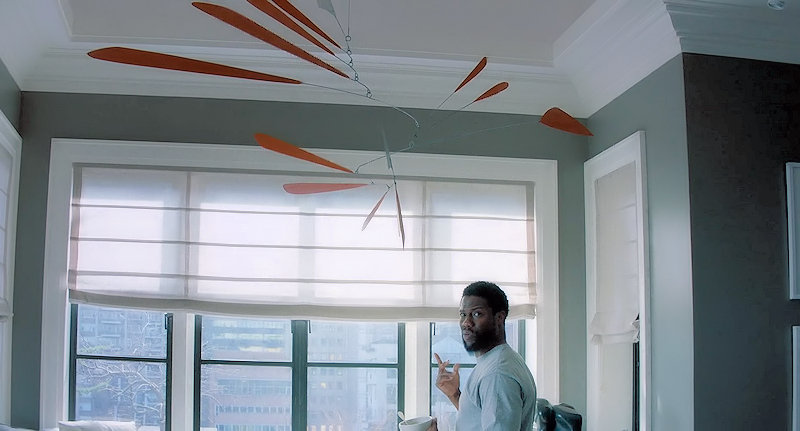

The blueprint of the mobile in the design of the comprehend of the Bryan Cranston'southward graphic symbol'due south volume:

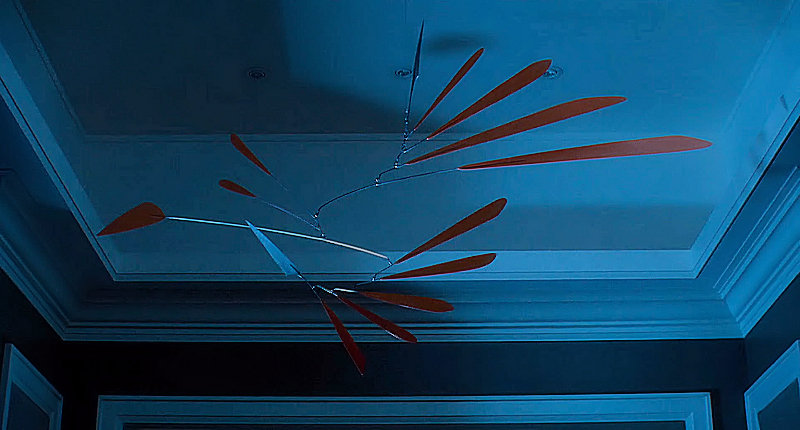

The pic fix for the bedroom scenes with the mobile:

The mobile suspended in my store before shipping it to the movie ready in Philadelphia:

My custom-made Mobile 92 that served as inspiration for the blueprint:

The art credits at the stop of the picture show:

A 3D "wing-around" blitheness of the calculator model of the mobile:
From our local neighborhood newsletter:
Fan Artist Commissioned for Major Hollywood Film
By Katherine Jordan, Marco Mahler
In tardily 2016, Fan resident and kinetic sculptor Marco Mahler received a telephone call from Alyssa Wintertime, who introduced herself as the banana set decorator for a pic under the working championship Untouchable. She was interested in the possibility of having a large mobile sculpture custom created for the movie. Apparently much of the pic was yet in the early stages and yet to exist decided, including members of the cast, but the fact that she had previously worked every bit set manager for the television receiver series Mr. Robot gave him an indication that this might be a major picture.
They discussed the work of artists, such as Alexander Calder and Bruno Munari, the present copyright holders of their work, and possible implications of making and showing a mobile sculpture similar to theirs in a movie. Mahler sent some initial pattern ideas that she presented to the director of the motion picture, who turned out to be Neil Burger (who also directed Divergent, Limitless, and The Illusionist). They decided to committee Mahler for the mobile for the moving picture and sent him a sketch of what they had in mind, modeled after an original work that he featured on his website. "The sketch they sent looked great, simply the structure of it would never take worked as a mobile," Marco Mahler remarked, "In a truthful mobile, the balance of the upper parts depends on the weight of the lower parts. If the sketch they sent would have been made equally a mobile, the structure of it would take just collapsed." Over the next month, they reworked the design, with him sending images and animations of new design variations to the fix director Beth Rubino (IMDb) so sending back comments on the new designs from Neil Burger. By the cease of Jan 2017, the design was finalized, and by mid-February, the mobile had been made and shipped to the movie fix in Philadelphia, where the set crew installed it with the assist of instructions that he sent along.
In the meantime, more than details near the film emerged. The title of the motion-picture show had been changed to The Upside, and Bryan Cranston, Kevin Hart, and Nicole Kidman were cast for the main characters. The picture is a remake of the 2011 French film The Intouchables, which grossed over $400 million worldwide, making it the highest-grossing movie in a language other than English language. Based on a real-life story and very similar to the original movie, The Upside follows a paralyzed billionaire (Bryan Cranston) who strikes upwardly an unlikely friendship with a recently paroled convict (Kevin Hart). Marco Mahler added, "As I understood in the early stages of the movie when designing the mobile, I believe that Bryan Cranston's character receives the mobile equally a souvenir from his wife. Subsequently she passes abroad, the mobile becomes a symbol and reminder of their past love and marriage. Last I heard regarding the whereabouts of the mobile, Beth said they might display it at the premiere of the picture."
The Upside is scheduled for release on January 11, 2019. In the meantime, yous tin see the mobile in the trailer for the picture show and cheque-out more of Mahler's work at www.marcomahler.com.
Custom dimensions for the mobile:

Additional ideas from the design process:








Mobile modeled afterwards The Upside mobile made from a Dr. Pepper tin by Jason 50 Nuttle:

Additional links:
"The Upside" Is the Money
Movies and Television to Watch for the Interior Design (featuring The Upside)
October 23rd 2018 – The Upside premieres at Philadelphia Flick Festival
Nov 2018 – Fan Artist Commissioned for Major Hollywood Moving picture
Jan 13th 2019 – The Upside Tops Aquaman With Surprising $19.6M Weekend
February 27th 2019 – The Upside With Kevin Hart and Bryan Cranston Tops $100 Million Box Office
Artists whose artwork is also shown in the movie:
Rick Bartow
Helen Frankenthaler
Alex Katz
Lee Krasner
Saul Leiter
Robert Motherwell
Paul Bonet
Ed Ruscha
Kiki Smith
Cy Twombly
Robert Mapplethorpe
Edward Burtynsky
Joel Meyerowitz
Marilyn Minter
– Run into more than of my custom designed mobile sculptures –
New Gimmicky Original Mobile Sculptures in Progress – Part one
Some snapshots of new mobile sculptures I'm currently working on:






These are truthful mobiles, significant they are kinetic and based on the same remainder structure as a Calder mobile, withal original and contemporary in pattern.



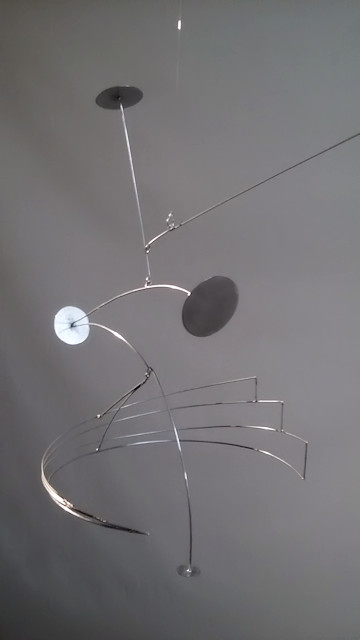


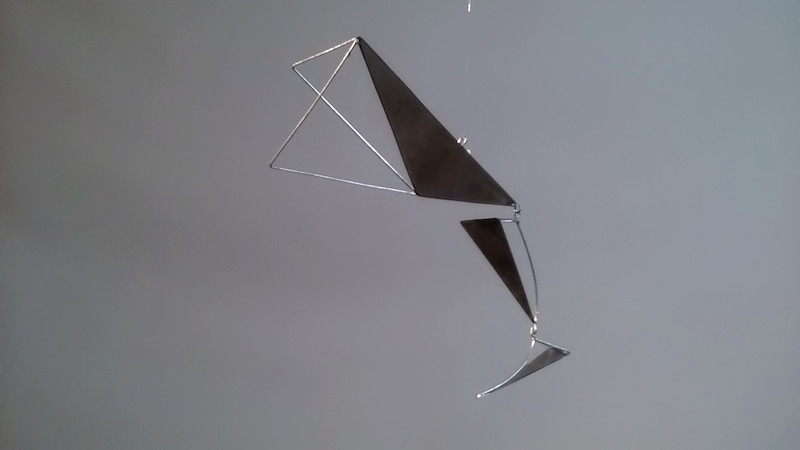
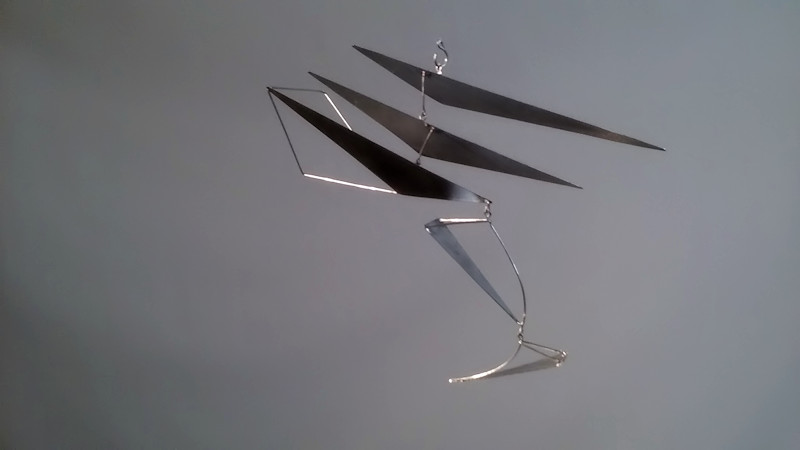







Run into New Contemporary Original Mobile Sculptures in Progress – Role 2
See an boosted gimmicky mobile sculpture
Run into more of my mobiles
Busy, Decorated, Busy – Some of the Custom Mobiles I'g Currently Working On
I'chiliad sorry about the lack of blog posts lately, I've been very busy. Merely for now, here are some of the custom mobiles I'thou currently working on:

A custom mobile for a foyer at a private residence in Miami, Florida. A draft of the mobile photoshopped into the 2 level infinite:

A iii story custom mobile for a light well at a individual residence in Chicago:

An boosted design for the aforementioned space:

A custom mobile for the Titus Uncomplicated School in Warrington, PA:


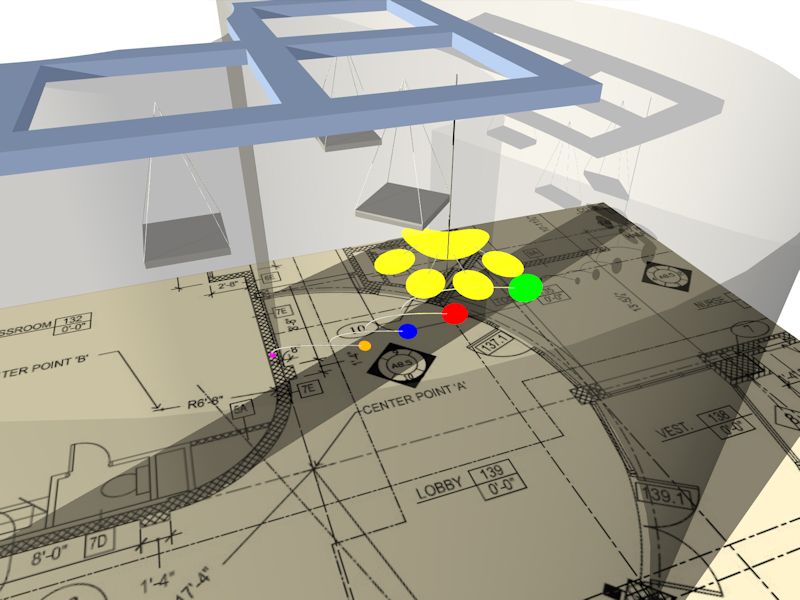
A custom mobile for a staircase at a private residence in Hong Kong:

A proposal for a individual residence in Miami Embankment:
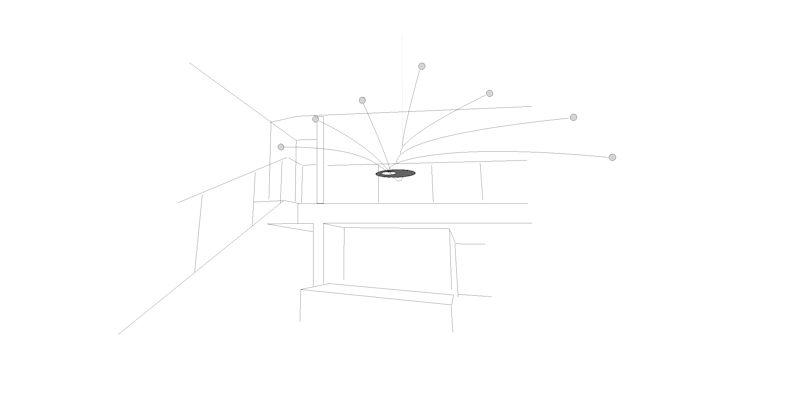
Some (not yet made) ideas / mobile designs:



A render of a Calder-way mobile:

And sometimes all kinds of things break loose:

I'm also working on an additional new large calibration projection that I'm very excited about and will be posting about shortly.
– See more of my custom mobiles or read more than of my blog well-nigh mobiles –
New big hanging mobile – Mobile 92
Just finished making a 6 foot (2 meter) sheet metal version of this hanging mobile design (a bird?):

It looks amazing! And moves amazingly well too with the wind currents. I can't wait to post photos of it, maybe a video, too. Non sure yet what would be the best place / background for pictures. A plain white simple space? A farm? Maybe a lake.
[Update: Image with Mies van der Rohe daybed]
Copyright © 2022 Marco Mahler
Source: https://www.marcomahler.com/category/new-kinetic-sculptures/
0 Response to "Review Latest Nails Solo Show Two Dimensional Art Building Sculptures New York"
Post a Comment